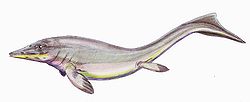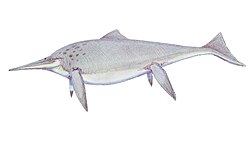Baisesaurus
Baisesaurus (meaning "Baise lizard") is an extinct genus of ichthyosauromorph reptiles from the early Triassic (Spathian age) Luolou Formation of Guangxi, China. The genus contains a single species, Baisesaurus robustus, known from a partial postcranial skeleton. Discovery and namingThe Baisesaurus holotype specimen, CUGW VH107, was discovered in 2018 in a layer of the Luolou Formation (Triassospathodus symmetricus–T. homeri conodont assemblage zones[1]) in the Nanpanjiang Basin of Zhebao Township in Baise, China. The specimen consists of assorted ribs, gastralia, a limb element (likely a radius), twelve vertebral centra, and seven neural arches.[2] In 2022, Ren et al. described Baisesaurus robustus, a new genus and species of basal ichthyosauromorphs. The generic name, "Baisesaurus", combines a reference to the type locality in Baise, China, with the Greek "saurus", meaning "lizard". The specific name, "robustus", means "robust".[2] Description and classificationBaisesaurus was likely at least 3 m (9.8 ft) long. It was more similar to Utatsusaurus than to any other ichthyosauromorph, with similar size and anatomical traits. It can be inferred from related animals that Baisesaurus was a strong swimmer with long, compact forelimb bones.[2] Baisesaurus likely represents a basal member of the clade Ichthyosauromorpha, albeit outside of the clades Hupehsuchia or Nasorostra. In their 2022 description, Ren and colleagues explained that it may more precisely represent a member of the Ichthyopterygia, but such a classification is highly tentative.[2] References
|
||||||||||||||||||||||||






















